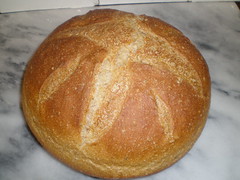If you search for homemade yogurt recipes online you will find many, but I think that I have streamlined the process significantly (using the microwave and a single container for all steps). Homemade yogurt is fun, easy, and very economical--a serving costs about the same as a glass of milk. It's delicious, and you know exactly what is going into your body or your children's.
The biggest issue is how to "incubate" your yogurt. The mixture must be held at a warm temperature for several hours (8 to 12). You can do this in a commercial yogurt maker, or try one of the suggestions below.
Here's my streamlined method. You will need:
~Milk (any kind you prefer, I use whole milk)
~Yogurt (you need a small amount of LIVE CULTURE plain yogurt to inoculate your first batch. After that you can save some of your homemade yogurt for the next batch)
~Powdered milk (optional--this helps thicken the yogurt)
I make about 3 cups of yogurt at a time. You can make more or less, depending on your container. I like to do it all in the microwave, using a quart-sized wide-mouthed glass canning jar. This is part of what makes it so easy--only one container is dirtied. Alternatively, you can use a large microwave safe bowl or a pyrex measuring cup (we have a pyrex measuring cup that holds 2 quarts and it's safe and easy to use). You may also heat the milk over the stove with a double boiler.
CAUTION: A glass container of 180 degree milk is HOT enough to cause serious burns!!!! Take adequate precautions. Use oven mitts or insulated rubber gloves to handle the hot container. Treat the container gently and do not set it down on a cold, wet surface. Use only canning jars that can withstand the heat--don't use fancy, decorative non-canning jars or reuse commercial jars unless you are certain they are not going to explode from the heat!
Make sure that everything is clean. Some sites recommend sterilizing everything, but I haven't had any trouble with just usual kitchen cleanliness. I wash my quart jars in the dishwasher between uses. And it's OK to use metal utensils--it will not hurt the yogurt or the utensil. However, the acid in the yogurt can be corrosive over time, so don't try to store it in a metal container.
Step 1: Bring the milk to 180 degrees F. I fill my quart jar with three cups of milk--any more and it would overflow during heating. That takes about 5 minutes to heat to 180 degrees in my microwave. You will need to experiment with your own microwave and container to determine how long to get to that temperature. Or heat the milk in a double boiler. Use your thermometer to check the temperature. Yogurt will not work if the milk gets too hot.
Step 2: Once the milk has reached 180 degrees, remove from the heat source. Add powdered milk (I use about 1/3 cup for 3 cups of milk). Allow the milk to sit at room temperature until it reaches 120 degrees. This takes about 20 minutes for a quart-sized jar.
Step 3: Mix in the yogurt culture. For Every two cups of milk, add about 2 TBSP of yogurt with active cultures. Stir gently. Don't add the culture until the milk has cooled to 120 or you will kill it.
OK, so now all you have to do is to "incubate"--that is to try to keep the mixture warm so the yogurt has time to do its thing. Here are some easy, low tech solutions:
1. I have a thermal "Lunch Jar" that my quart canning jar fits inside with a little bit of room. I preheat the thermal jar with warm water and then pour it out before slipping in the sealed quart jar of yogurt mixture. Because there is space on the sides, I wrap the quart jar with wash cloths for added insulation. Cover the lunch jar tightly. My lunch jar is not a fancy vacuum thermos, so I wrap the lunch jar in an insulated lunch bag for further insulation. Set aside in a draft free spot overnight, 8-12 hours.
2. If you have a wide-mouth vacuum thermos, that's an excellent incubator. Preheat the thermos with some warm water for about 5 minutes before filling it with the yogurt mixture.
3. Crockpot two ways:
a. Preheat the crockpot on low while you are making the yogurt mixture. Turn the crockpot OFF and unplug it. Pour the milk mixture in the crockpot, cover, and wrap the crockpot up in blankets and towels to insulate it. Wait 8 to 12 hours. This is especially good for large quantities of yogurt.
b. Preheat the crockpot as above. Turn the crockpot OFF and unplug it. Wrap your sealed quart jar of yogurt mixture in a thick towel and place it in the crock. Put the cover on the crockpot and wait 8 -12 hours.
4. If you look around on the web, there are other incubators you can try, like a heating pad in a styrofoam cooler, the oven turned on very low, etc. I prefer the thermal jars--you can pick up a thermal water jug for just a few dollars and that will work fine. No electricity and no close monitoring needed. I've also been thinking that some of the ice buckets you can pick up inexpensively at thrift stores would make good incubators. And of course, a commercial yogurt maker works just fine.
The longer you incubate, the thicker the yogurt, but I do find my homemade yogurt is generally thinner than commercial yogurt. I strain the yogurt in a permanent coffee filter with a plastic mesh for about 2 hours to remove some of the liquid whey and thicken it up. If you want Greek-style yogurt or yogurt cheese, just strain for a longer time period. You can save the whey and use it in bread baking--it acidifies and conditions the dough very nicely. Ha, there is a bread baking angle here!
Before eating your yogurt, fill a small plastic container (I always fill two) with some of your new yogurt to use to inoculate the next batch. You can freeze this for later use. I got some great small plastic lidded containers from the Dollar Store that each hold the exact amount needed for a batch of yogurt.
Flavor the yogurt however you like. We like honey or jam in our house. The longer the yogurt incubates, the more sour the flavor, so you will want to cut the flavor with at least a little sweetener to get your kids to eat it. You can also add pureed fruit. This yogurt is great with homemade granola.
Enjoy!


Your yogurt is thin because you don't heat it long enough. See this website: http://www.blog.sethroberts.net/2010/07/01/homemade-yogurt-tip/
ReplyDeleteWe used to heat milk as you describe i.e. heat to 180 and cool. Now, we heat our milk to about 180F for 10-20 minutes and it comes out quite thick.